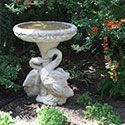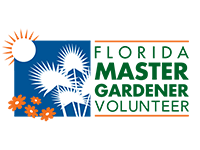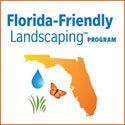The Neighborhood Gardener –
Inviting Wildlife to Your Yard
Here in Florida, we're lucky to have incredibly diverse wildlife. You can welcome wild creatures into your yard by doing a few simple things.
Wildlife are similar to humans in what they need. To be happy and thriving, they need food, water, cover, and space. Plant foliage and flowers that will give butterflies, birds, and bees a range of habitats and food sources to choose from. Learn more about landscaping for wildlife.
All living things need water. Make sure you have a source for wildlife, either natural or built. Birdbaths are an easy way to provide a water source. Learn more about birdbaths.
Getting wildlife to come to your yard starts with food and water, but to get them to stay they need cover, or houses. Focus on a few of your favorite Florida wildlife—there are simple DIY plans available for houses that you can make.
Bat Houses
Bats are incredibly beneficial creatures, since a single bat can eat thousands of insects each night. Unfortunately, bat populations are declining due to loss of habitat. Consider following these guidelines and installing your own bat house: Effective Bat Houses in Florida.
Toad Houses
Toads are a favorite among the littlest gardeners, and you can be sure to delight your young ones by inviting toads to your yard. Not only are they fun for kids, but the average toad will also eat 50 to 100 insects every night. Choose a cool, damp, spot in your landscape away from foot traffic and preferably near a shallow water source. Bury a clay pot about halfway in the ground on its side, which will provide toads with a cool roof and a dirt floor. Read more about toad houses.
Birdhouses
Birds are plentiful in Florida with more than 25 species that need cavities or holes in trees for their nests. In general, birdhouses should include ventilation holes and a hinged door or other way to easily check and clean out the house. Your birdhouse should have an overhang above the entryway to keep out rain, but also should include several small holes to drain any water that does get in. Attach your birdhouse firmly to a post, tree, or building.
Many cavity-nesters have specific requirements for their homes, so birdhouses should be targeted to a particular species.
Read more about birdhouses.
Snags
We can't mention wildlife habitat without mentioning dead trees, also called snags. Leaving dead or dying trees where they stand helps out wildlife. Snags provide food as well as shelter. Insects live in snags which small birds feed on. Birds of prey often use snags as hunting and nesting perches. If you're planning to have a tree removed, consider leaving part of it as a snag for the wildlife. Remember, dead trees can pose a safety issue. Only leave them if they don't have "targets" like houses, cars, or people. Read more about snags.





